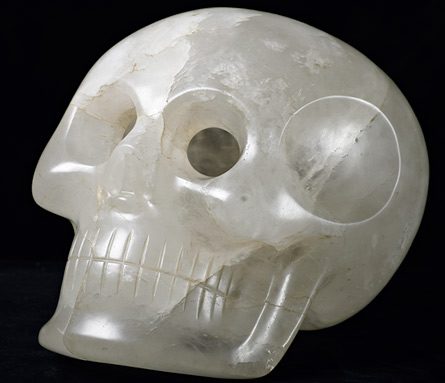Fakes in the museum
A close-up examination of crystal skulls reveals the true, recent origins of these "relics"
 |
|
New research indicates that this crystal skull, housed at the Smithsonian Institution, was made in the 1950s, not by Aztecs more than 500 years ago as some have thought. |
| Smithsonian Institution/James Di Loreto |
Indiana Jones might have saved himself a whole lot of trouble in his new movie if only he had known the crystal skulls he traveled so far to find were probably fakes.
Crystal skulls, carved from a see-through mineral called quartz, have been thought by some scholars to be relics of the Aztecs or other peoples living in Central America about 500 years ago, between the 14th and 16th centuries. The stuff of legends, the skulls’ otherworldly appearance has even led some to believe that they have healing properties and came not from Aztecs but from a mysterious civilization that disappeared from the Earth long ago. Some even suggest the skulls, which Europeans began collecting in the mid-1800s, came from another planet entirely.
It turns out the skulls’ origins are probably much more humble. Museum historians and archaeologists have long suspected that crystal skulls, especially large ones, may be modern-day forgeries and not the objects of a bygone civilization. Most of the life-sized crystal skulls found in museums have no documents recording where, when or how they were dug up, or who originally found them. The large size of the skulls also stands out from the much smaller skull carvings more commonly found in Aztec dig sites. These observations long raised many peoples’ suspicions about the skulls. Are they really as old as their collectors say they are?
To find out, a team of archaeologists recently analyzed two life-sized crystal skulls, one housed in the British Museum in London, and the other at the Smithsonian Institution in Washington, D.C. By closely examining the surface of the skulls, the researchers determined what kinds of tools were used to make the skulls. For comparison, they also examined the surfaces of several beads and a drinking cup collected from archaeological digs at Central American spots known to be between 1,000 and 500 years old.
To get a close-up look at the surface of each object, the researchers used a tool called a scanning electron microscope. This high-magnification tool sends a beam of electrons through an object to form an image. To work properly, the object scanned needs to be coated with a very thin layer of gold, which helps conduct the electron beam through the sample. Rather than coat the museum specimens with gold, the team pressed a type of wax onto the surface of each specimen to make a precise mold. Viewing this wax mold with the powerful magnification provided by a scanning electron microscope gave the researchers a very detailed view. They were able to look carefully at the fine markings left behind by the tools used to make the skulls, as well as the beads and cup.
Under magnification, the cup and beads have the kinds of markings that would come from wood and stone tools. They were shallow and irregular, as you might expect from a piece carved by hand. The skulls, however, had more uniform surface patterns. The researchers say the pattern found on one of the skulls is the same kind of pattern produced by a more modern tool — a mechanical wheel like those used by jewelry-makers today. This suggests the large skulls were carved with modern equipment that would not have been available to the people living long ago, says Jane Walsh, an anthropologist at the Smithsonian Institution.
Further analysis of the quartz in the other skull suggested the rock it was made from came from Madagascar, Europe or Brazil — all very far from the Aztec empire, and not at all connected to the empire by any trade network. Taken together, these pieces of evidence support the idea that the life-sized crystal skulls are modern-day phonies.
What about the many smaller crystal skulls housed in other museums around the world? Walsh says they’re probably fakes, too. But archaeologist Michael E. Smith at Arizona State University thinks otherwise. While he agrees the large skulls are probably fakes, “some small crystal skulls may indeed be legitimate Aztec objects,” he says.
Going Deeper:







